 |
|
|
Automotive: test bench and production control
|
|
For many years, Micro-Epsilon has been a partner to the automotive industry and its suppliers. Whether in the test bench, in production monitoring or in plant construction - Micro-Epsilon sensors ensure precise and reliable measurements in numerous applications. Globally organized, Micro-Epsilon provides efficient collaboration with the global automotive industry. |
|
|
Position detection of car bodies in the processing line
|
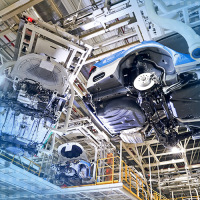 |
Before a car emerges from a bodyshell, it passes through numerous stations within the production, in which fully automatic processing steps are carried out. In order to enables the processing robots to recognize the exact position of the car body, several laser triangulation sensors measure the car body and transmit the position data to the robot controller.
  Smart laser triangulation displacement sensor Smart laser triangulation displacement sensor
|
|
|
|
Laser profile scanner for cockpit assembly in cars
|
|
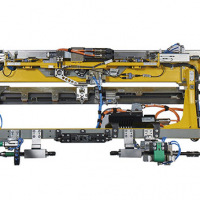
|
Fully or semi-automatic assembly of cockpit modules in the automotive industry requires the gripper tool to precisely position the assembly parts. As the laser scanners take over the measurement and positioning tasks, each cockpit module is individually adapted to the respective car body. Micro-Epsilon laser scanners are particularly suited for these measurement tasks due to their SMART functions and the particularly small and lightweight measuring head. They can be easily installed on a robot or manipulator.
Using the SMART function, a parameterization of the sensors can be realized without further hardware components via Ethernet. In addition, measured values can be visualized and transmitted directly to the controller. The precise scanCONTROL laser profile sensor evaluates the complete profile internally and transmits the measurement values via Ethernet to the control system. This enables the actuators to change the axis positions on the gripper in order to assembly the cockpit module in the ideal position in the car body. After the cockpit is fixed, the sensor determines the installation position of the cockpit which serves as proof of quality for each vehicle.
|
|
|
For the entire process including the fitting of the cockpit, an extremely short cycle time of less than one minute is required. Measuring independent of surface conditions, the sensors provide reliable measurement values whether bright or dark paints are used, different gloss levels, variable surface structures and in unsteady ambient light conditions. The sensor automatically readjusts the exposure.
  Laser scanners for 2D/3D profile measurements Laser scanners for 2D/3D profile measurements
|
|
|
Fully automatic paint defect inspection of car bodies and attachments
|
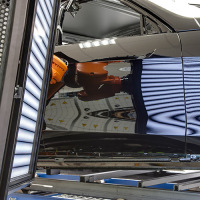 |
Particularly with shiny surfaces, a faultless production chain is expected in order to lend a sophisticated visual appearance to the final product. For fully automatic defect detection on car bodies and attachments, the reflectCONTROL inspection system is used. The system projects a striped pattern onto the surface. Deviations caused by defect are recorded with two cameras and evaluated via software.
  Fully automatic surface inspection of painted car bodies Fully automatic surface inspection of painted car bodies
|
|
|
|
Detecting surface defects
|
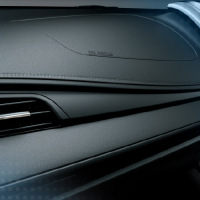 |
As well as the visual requirements, instrumentation panels also have to fulfill functional and security requirements. Often the passenger airbag has a predetermined breaking line which is generated using a laser. This »weak point« ensures the safe opening of the airbag at the predetermined breaking line. Sink marks may appear, which can be recognized under certain light conditions. In order to recognize these defects, surfaceCONTROL inspection systems are used which enable fast and objective evaluations to be made of the characteristics of any shape deviations, both on grained and smooth surfaces.
  Inspection of diffuse reflecting surfaces Inspection of diffuse reflecting surfaces
|
|
|
|
Behavior of the combustion engine in the test bench
|
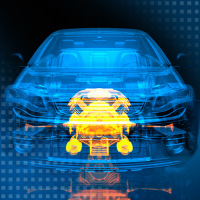 |
Eddy current sensors from Micro-Epsilon are considered as proven measuring instruments in the test bench of combustion engines. In towing mode as well as in the firing mode, the sensors detect different quantities which contribute to the improvement of the engine characteristics. In particular, the high measuring accuracy provided under harsh conditions in the engine distinguishes the eddyNCDT eddy current sensors.
  Inductive sensors (eddy current) for displacement, distance & position Inductive sensors (eddy current) for displacement, distance & position
|
|
|
|
Monitoring the sheet metal infeed during pressing
|
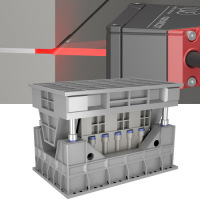 |
During forming in the pressing plant, the presence detection and the detection of the exact sheet metal position are required. Therefore, laser triangulation sensors measure on the sheet between the dies. The challenge here is to achieve high measurement accuracy in tight spaces despite oil mist, vibrations and shocks. Since the measuring gap is very small, the diameter of the laser must be correspondingly low.
  Smart laser triangulation displacement sensor Smart laser triangulation displacement sensor
|
|
|
|
Gap measurement in aluminum die casting processes
|
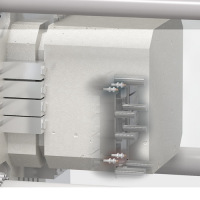 |
In aluminum die casting, liquid aluminum is poured into molds under high pressure and at high speeds. The high pressure acts on the closed mold and pushes it apart, which is why splinters and burrs might occur during casting. In order to measure the pressure-induced movement of the molds, eddy current sensors detect the change in distance. These robust sensors provide reliable measurement results despite high temperatures, ambient pressure and a dirty measuring gap.
  Inductive sensors (eddy current) for displacement, distance & position Inductive sensors (eddy current) for displacement, distance & position
|
|
|
|
Measuring the brake disc deformation (Disc Thickness Variation)
|
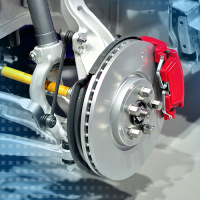 |
With the capaNCDT DTV, Micro-Epsilon has developed a product range that is specifically used for non-contact detection of the Disc Thickness Variation. Thickness measurements of brake discs can be carried out in test benches, in road tests or in car repair shops using non-contact, capacitive displacement sensors, which detect the thickness of the brake disc from both sides.
  Measuring Disc Thickness Variation Measuring Disc Thickness Variation
|
|
|
|
Road tests - Detection of the brake temperature under load
|
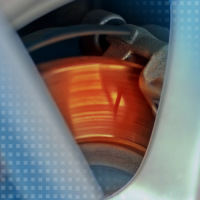 |
The temperature behavior of brakes plays a major role in vehicle development. In particular, the duration of heating and cooling of the brake discs provides information about the efficiency of the brake system. In test bench and road tests, non-contact temperature sensors from Micro-Epsilon measure the temperature development during braking. The compact design and the short response time of the pyrometers enable universal use in test bench and road test applications.
  Infrared pyrometers for universal measurements/span> Infrared pyrometers for universal measurements/span>
|
|
|
|
Gap measurement in robot-based assembly
|
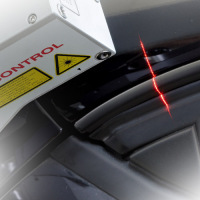 |
In modern production lines, scanCONTROL laser scanners are used to reliably inspect the gap sizes of the car body quickly and consistently. Thanks to surface compensation, measurements are possible on a wide variety of body paintworks.
  Laser scanners for 2D/3D profile measurements Laser scanners for 2D/3D profile measurements
|
|
|
|
|
|
LED color inspection of vehicle lights
|
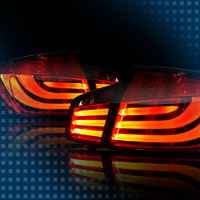 |
Color and intensity of vehicle lights must be reliably inspected prior to assembly and delivery. Homogenous distribution of light should also be ensured with fluctuating LED batches. The colorCONTROL MFA is a special LED test system designed to test inaccessible and widely spaced test specimens. Optical fibers enable simultaneous measurement of up to 20 measuring points.
  Sensor systems for LED color and intensity tests Sensor systems for LED color and intensity tests
|
|
|
|
|
|
Color inspection and sorting of supplier parts
|
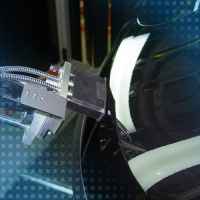 |
Before installing front aprons, Micro-Epsilon color sensors check if the color of the attachment matches the body color. Different color groups can be defined to cover all coatings.
  Compact True Color Sensor Compact True Color Sensor
|
|
|
|
|
|
Monitoring embossment depth
|
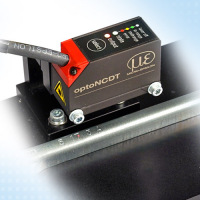 |
In embossing machines, car body IDs are punched into the vehicle frame. The embossment depth must be in a defined tolerance range. In order to position the embossing tool, laser triangulation sensors from Micro-Epsilon detect the distance between the embossing tool and the component. After the embossment is finished, the sensor measures the profile of the embossment and ensures that all characters are embossed to the required depth.
  Smart laser triangulation displacement sensor Smart laser triangulation displacement sensor
|
|
|
|
|
|
Inline burr measurement on sheet edges in body manufacture
|
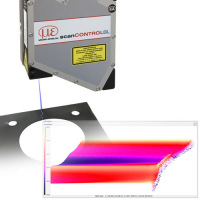 |
In order to avoid corrosion, continuous and error-free corrosion protection is a critical factor in the painting process. As the thickness of the applied painting on burrs can only be determined under challenging limitations, it is a decisive advantage when the burrs are recognized early in the production process before the corrosion protection and other paint layers are applied. In contrast to fixed solutions that enable a random test, Micro-Epsilon offers its scanCONTROL 2910-10/BL Plug & Play system which provides the required precision with its high point resolution of approx. 8µm along the laser line in order to recognize burrs reliably even during inline measurements.
  Laser scanners for 2D/3D profile measurements Laser scanners for 2D/3D profile measurements
|
|
|
|
|
|
Distinction of brake discs
|
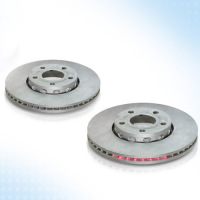 |
When processing car brake discs, the correct brake disc must be chosen before each stage of production in order to assign them to the manufacturer's different models. Laser scanners are used to recognize and classify the brake discs. The challenge of brake disc distinction is that the test objects are the same with regard to form, height and diameter. The gapCONTROL laser scanners are used for 100 % recognition and subsequent sorting. The only distinctive feature is a gap between two ventilation blades that signifies the respective models of the manufacturer.
|
|
|
|
|
|
Valve lift measurement in the MultiAir cylinder
|
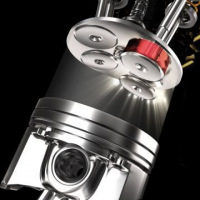 |
The MultiAir cylinder procedure patented by FIAT / Schaeffler controls individual valves independently of the camshaft. An electro-hydraulic control system provides fully variable valve control. Therefore, the stroke and the opening/closing times of the inlet valve are freely controllable. This reduces fuel consumption and CO2 emissions with a simultaneous increase in engine performance and torque. During the end-of-line inspection of the MultiAir components, a test bench simulates the conditions inside the engine. Eddy current sensors from Micro-Epsilon measure the exact valve lift.
  Inductive sensors (eddy current) for displacement, distance & position Inductive sensors (eddy current) for displacement, distance & position
|
|
|
|
|
|
Color comparison between parking sensor and body shell
|
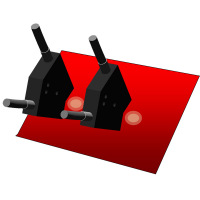 |
Car attachments such as parking sensors are painted separately. However, during assembly there must be no difference in color between the parking sensor and the bumper, which means the two colors must be identical. The colorSENSOR from Micro-Epsilon enables a direct color comparison between the parking sensor and the rear bumper.
  Compact True Color Sensor Compact True Color Sensor
|
|
|
|
|
|
Color recognition for seams in automotive interiors
|
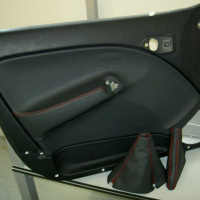 |
In the assembly line of a well-known German car manufacturer, similar car interior parts must be differentiated from each other based on the respective seam color. Previously, professional testers have visually checked the seams. In order to automate the process and to optimize it economically, colorSENSORs from Micro-Epsilon are now being used.
  Compact True Color Sensor Compact True Color Sensor
|
|
|
|
|
|
Vibration displacement measurement in road tests
|
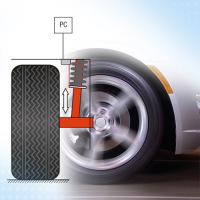 |
In the automotive industry, testing the chassis is a prerequisite for driving safety. Here, sensors are required which can also withstand the high demands of road tests. For example, draw-wire sensors are mounted in parallel to the shock absorbers for the vibration displacement measurement and the data is recorded under varying road-surface properties. The displacement signal obtained is differentiated to calculate the vibration velocity and vibration acceleration.
  WDS-MPM WDS-MPM
|
|
|
|
|
|
 |
|
|
Automation
|
|
Increasing networking in factory and plant automation requires the immediate availability of all relevant operating information. Here, intelligent networking of development, production and logistics is a central challenge. Smart sensors from Micro-Epsilon ensure the optimal integration and networking of machines and processes due to their versatile industry interfaces and evaluation algorithms. Thanks to their high precision, the sensors often replace switches in order to react to events more quickly and accurately. |
|
|
Position detection of car bodies in the processing line
|
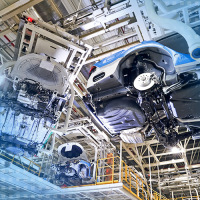 |
Before a car emerges from a bodyshell, it passes through numerous stations within the production, in which fully automatic processing steps are carried out. In order to enables the processing robots to recognize the exact position of the car body, several laser triangulation sensors measure the car body and transmit the position data to the robot controller.
  Smart laser triangulation displacement sensor Smart laser triangulation displacement sensor
|
|
|
|
Measuring applied adhesive of tapes, plasters and Band-Aids
|
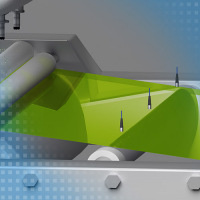 |
To ensure a homogeneous adhesive surface, capacitive displacement sensors measure the thickness of the adhesive on adhesive tapes and medical plasters. Capacitive sensors allow one-sided thickness measurement. Depending on the system structure, conductive or non-conductive adhesives can be measured.
  Capacitive displacement sensors and measurement systems Capacitive displacement sensors and measurement systems
|
|
|
|
High precision thickness measurement of silicon wafers
|
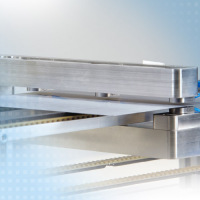 |
Capacitive displacement sensors are used for the exact thickness measurement of wafers. Two opposing sensors detect the thickness and also determine other parameters such as deflection or sawing marks. The position of the wafer in the measuring gap may vary.
  Capacitive displacement sensors and measurement systems Capacitive displacement sensors and measurement systems
|
|
|
|
Presence detection of small parts
|
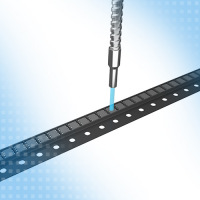 |
In assembly processes, incoming components are inspected using Micro-Epsilon fiber optic sensors. Recognizing missing SMT components enables a smooth assembly process. Their flexible design allows for the optoCONTROL CLSK probe heads to be integrated in confined spaces.
  Fiber optic sensors for gap, diameter, edge and presence Fiber optic sensors for gap, diameter, edge and presence
|
|
|
|
Thickness measurement of black rubber belts
|
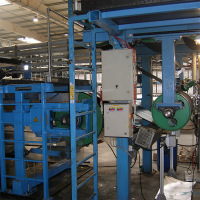 |
Rubber mats for the structure sealing must exhibit a specified thickness for durability and tear resistance. The thickness of the films is measured directly after the extrusion. The optoNCDT 1750 sensors used measure the distance to the rubber despite poor reflectivity. The thickness is determined from the sensor signal and the distance to a reference roller. The user thus recognizes already starting deviations from the target thickness.
  Universal laser sensor for industry & automation Universal laser sensor for industry & automation
|
|
|
|
Orientation of wooden boards
|
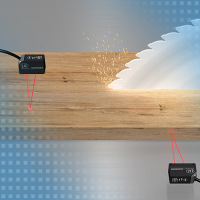 |
In fully automated sawmills, the position of wooden boards before sawing must be determined so that they can be cut precisely. Micro-Epsilon laser displacement sensors detect the position of the boards from two sides and output the board position to the controller.
  Smart laser triangulation displacement sensor Smart laser triangulation displacement sensor
|
|
|
|
Inspection of plate position
|
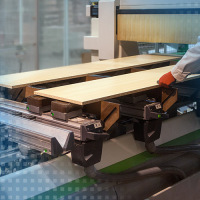 |
When printing woods with decors, optoCONTROL micrometers are used to control the positions of the plate. This prevents the printing head from colliding with the plate. These laser micrometers measure directly on wood and monitor the tools.
  High resolution optical micrometer High resolution optical micrometer
|
|
|
|
Inspection of wood floorboard relief
|
|
|
|
|
Profile inspection of parquet flooring and baseboards
|
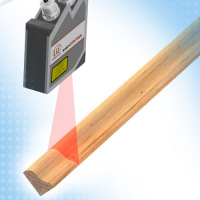 |
Laser scanners from Micro-Epsilon are used for the profile measurement of parquet boards and baseboards. They inspect geometric characteristics such as groove height, gap dimensions and absolute dimensions to ensure homogeneous product quality.
  Laser scanners for 2D/3D profile measurements Laser scanners for 2D/3D profile measurements
|
|
|
|
Color recognition of kitchen fronts
|
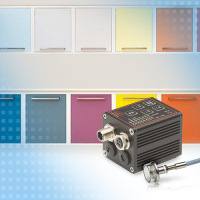 |
In order to ensure consistent color of different front panels, color sensors from Micro-Epsilon are used. The sensors inspect the color of the kitchen fronts in the painting plant. Color sensors ensure that the color shade is within the specified tolerances. Even the smallest color deviations imperceptible to the human eye can be detected reliably.
  Compact True Color Sensor Compact True Color Sensor
|
|
|
|
Dimension control of beams
|
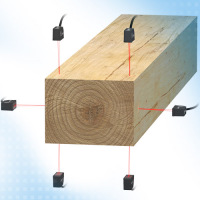 |
For thickness and width measurement of plates, planks and beams, two optoNCDT laser sensors are used. If this arrangement is complemented by further sensors, one synchronized measurement process can combine the inspection of torsion with control of dimensions.
  Smart laser triangulation displacement sensor Smart laser triangulation displacement sensor
|
|
|
|
Color inspection and sorting of supplier parts
|
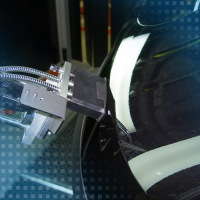 |
Before installing front aprons, Micro-Epsilon color sensors check if the color of the attachment matches the body color. Different color groups can be defined to cover all coatings.
  Compact True Color Sensor Compact True Color Sensor
|
|
|
|
Color measurement of the floorboards
|
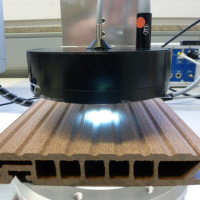 |
Plastic floorboards are made of colored granules and shaped by deep-drawing. After the production process, it must be guaranteed that the color of the floorboards is homogenous and that there are no color differences.
  High Speed Photospectrometer colorCONTROL ACS7000 High Speed Photospectrometer colorCONTROL ACS7000
|
|
|
|
In-line detection of protective film on PVC window frames
|
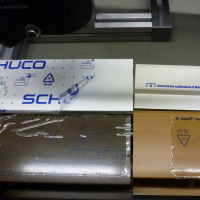 |
Company „Schüco“ manufactures PVC window frames. The PVC profiles are provided with a protective film after they are extruded. This film protects the frames from scratches and dirt. The colorCONTROL ACS7000 color measurement system checks if the protective film has been applied correctly.
  High Speed Photospectrometer colorCONTROL ACS7000 High Speed Photospectrometer colorCONTROL ACS7000
|
|
|
|
Calibrating robot axes
|
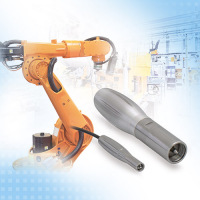 |
Industrial robots have become indispensable in modern production facilities due to their reliability and high speed. During set up and also at regular intervals within the scope of quality assurance, the robot axes must be adjusted. Here, electronic adjustment probes have already replaced mechanical probes. The measurement probes mounted on the robot axes acquire the zero point during the axis rotation using a probe tip. The integral electronics evaluates the probe signal and transmits a switching signal to the robot controller.
  induSENSOR LVDT gages DTA series induSENSOR LVDT gages DTA series
  Inductive sensors (LVDT) and gauges Inductive sensors (LVDT) and gauges
|
|
|
|
|
|
 |
|
|
Aerospace
|
|
In aviation, the highest requirements are placed on installed components in terms of safety and reliability. This especially applies to sensors which are used in different places. For example in aircraft assembly, sensors from Micro-Epsilon ensure non-contact rivet hole measurement. Micro-Epsilon develops displacement and position sensors for aircraft measurement tasks landing gear, wing assembly, fuselage and engines, where they enable reliable determination of measurement values. |
|
|
Non-contact inspection of rivet bore holes
|
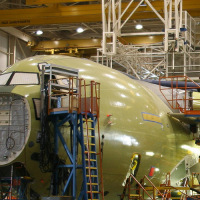 |
In aircraft construction, several hundred thousand rivets are usually used. Fully automatic machines are precisely fitting rivet holes and rivets. An optical inspection system from Micro-Epsilon inspects the inside diameter of the rivet holes without contact.
|
|
|
|
Brake temperature measurement
|
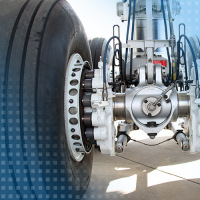 |
Before an airplane can start, the temperature in the brakes must be below a certain limit. To determine the temperature, non-contact temperature sensors from Micro-Epsilon are used in the landing gear.
  Infrared pyrometers for universal measurements Infrared pyrometers for universal measurements
|
|
|
|
Door lock detection
|
|
|
|
|
Reliable position recognition of the Wing-Tip-Brake
|
|
|
|
|
Load tests on airplane wings
|
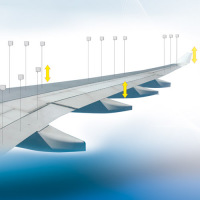 |
In order to optimize the behavior of wings during a flight, the wings are already subjected to vibration tests during the construction. 120 wireSENSOR draw-wire sensors are connected to the wing and synchronized. In this way, any change of the wing form in the vertical direction can be tracked.
  Draw-wire displacement sensors Draw-wire displacement sensors
|
|
|
|
|
|
 |
|
|
Additive Manufacturing
|
|
In additive manufacturing, different parameters have to be monitored. Particularly where high manufacturing quality is required, sensors from Micro-Epsilon monitor positioning, powder application and component dimensioning tasks. Laser sensors, laser scanners, inductive displacement sensors based on eddy currents and capacitive displacement sensors are just some of the sensors used. |
|
|
3D scan prior to laser cladding / laser deposition welding
|
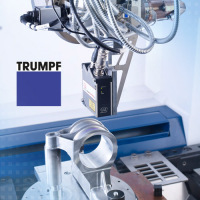 |
Laser scanners from Micro-Epsilon are used to detect the contour during laser cladding. These scanners detect the exact contour of the object before the weld is deposited. The 3D data is used to exactly determine the guidance of the weld head.
  Laser scanners for 2D/3D profile measurements Laser scanners for 2D/3D profile measurements
|
|
|
|
Deposition control of coatings
|
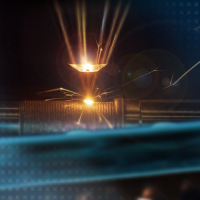 |
In coating processes based on laser cladding or laser deposition welding, laser scanners from Micro-Epsilon monitor the coating. Their high profile resolution enables reliable monitoring of the weld deposition.
  Laser scanners for 2D/3D profile measurements Laser scanners for 2D/3D profile measurements
|
|
|
|
CAD comparison of the printed component
|
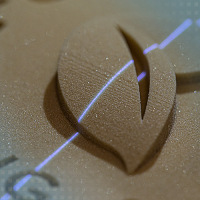 |
In order to monitor their production quality, printed components are inspected using Blue Laser scanners. The components are moved past the scanners with a traversing unit. A 3D image is produced from the laser profiles and then compared with the CAD data.
  Laser scanners for 2D/3D profile measurements Laser scanners for 2D/3D profile measurements
|
|
|
|
Print head positioning and focal point control
|
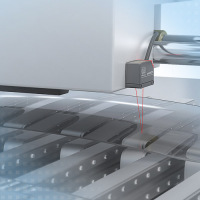 |
With printing processes, the exact height of the print head is a crucial factor for the quality of the final product. High-speed distance measurement against different material surfaces and reliable edge detection enable a fast readjustment process.
  Smart laser triangulation displacement sensor Smart laser triangulation displacement sensor
|
|
|
|
High-resolution fine positioning when printing PCBs
|
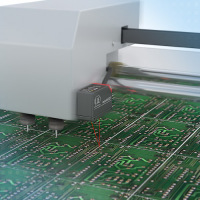 |
With printing, soldering and assembling processes of printed circuit boards, the exact height positioning of the print head is crucial for a flawless process. optoNCDT laser sensors enable precise positioning of the print head. Regardless of surface reflections, these sensors provide precise measurement results which are used to adjust the height and to detect the edges.
  Smart laser triangulation displacement sensor Smart laser triangulation displacement sensor
|
|
|
|
Glue bead measurement in dispensing systems
|
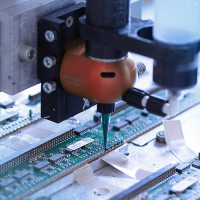 |
After the reflow soldering process, glue is applied on some points to protect the circuit. The glue bead thickness is a critical factor that is reliably inspected using laser sensors.
  Smart laser triangulation displacement sensor Smart laser triangulation displacement sensor
|
|
|
|
Orientation and positioning of the building platform
|
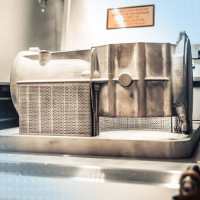 |
With selective laser sintering, the building platform is lowered after each melting cycle by a defined value which corresponds to the required Z resolution. Inductive displacement sensors based on eddy currents monitor this building platform in order to allow the print head to be aligned in parallel.
  Compact, inductive displacement measuring system for serial applications Compact, inductive displacement measuring system for serial applications
|
|
|
|
Robot path calculation in repair welding processes
|
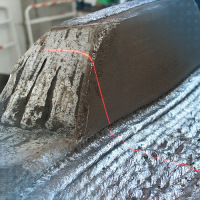 |
In order to calculate the robot path, scanCONTROL laser scanners determine the areas that need to be welded. Providing a high profile resolution and profile frequency, these laser scanners enable quick repairs.
  Laser scanners for 2D/3D profile measurements Laser scanners for 2D/3D profile measurements
|
|
|
|
Monitoring the tilted squeegee
|
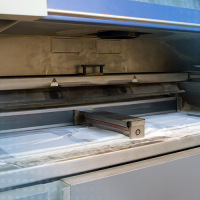 |
Capacitive displacement sensors monitor the position of the squeegee. Two synchronized sensors measure with high resolution both ends of the squeegee to provide exact statements about its tilt angle. This is to ensure that the powder bed has been pulled off evenly.
  capaNCDT 6200 capaNCDT 6200
|
|
|
|
|
|
 |
|
|
|
Other tools
Micro-Epsilon already offers a large range of integration and evaluation tools for laser profile scanners. This range is now complemented with other tools, which enable to check the transmission functionality between SMART scanners and a PLC based on the corresponding transmission protocol in order to determine whether the sensor transmits the data properly.
|
|
|
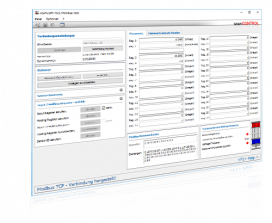 |
-
Checking the Modbus functionality
-
Recording measured values
-
Sensor control (e.g. Laser on/off), Loading user mode, ...)
|
|
|
|
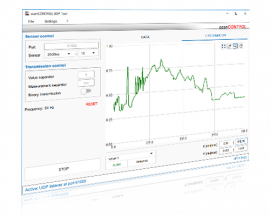 |
-
Checking UDP functionality
-
Recording measured values even with high profile frequencies
-
Source code available
|
|
|
|
|
|
|
|
|
|